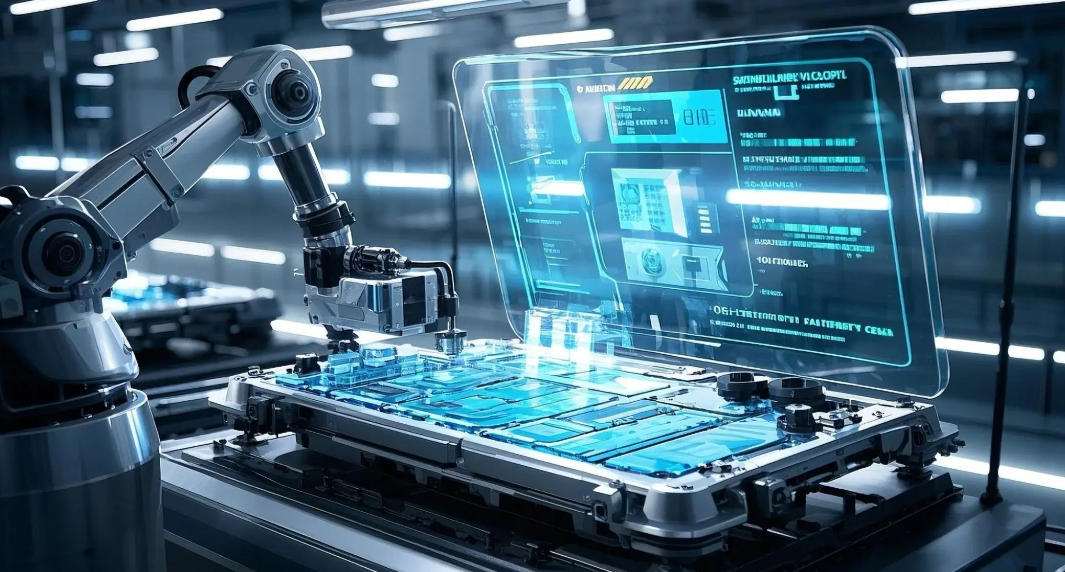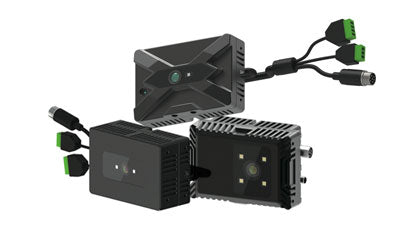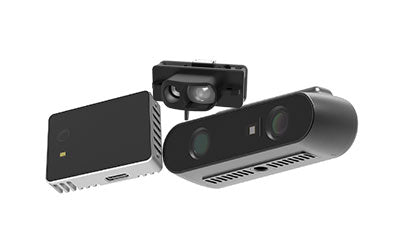ToF Sensors in Industry 4.0: Smart Manufacturing & Robotic Vision

How Do ToF 3D Sensors Improve Smart Manufacturing and Robotic Vision in Industry 4.0?
With the rapid advancement of Industry 4.0, smart manufacturing and robotics are transforming production models. Companies increasingly demand visual sensing capabilities, especially in precision assembly, unmanned warehousing, and intelligent robotics. High-precision, low-latency, and all-environment-adaptive TOF (Time-of-Flight) Sensors have become a key enabling technology.
What is Smart Manufacturing?
Smart manufacturing refers to the modern production paradigm that leverages advanced information technologies, sensor technologies, artificial intelligence (AI), the Internet of Things (IoT), big data analytics, and automated equipment to monitor, optimize, and make autonomous decisions in real time, improving production efficiency, product quality, and flexibility.
In simple terms, smart manufacturing is about 'machine connectivity + data-driven insights + autonomous optimization,' enabling factories to produce faster, smarter, and more precisely while reducing costs and energy consumption.
1. Visual Sensing Demand in the Era of Industry 4.0
As Industry 4.0 progresses, production lines are upgrading from traditional automation to highly intelligent systems, placing higher demands on visual sensing technologies. Industrial robots, intelligent logistics systems, and automated assembly lines increasingly rely on 3D Sensing Technology, 3D ToF Camera Modules, and 3D ToF Sensors to enhance production efficiency, quality control, and safety.
By integrating 3D ToF Modules and ToF Depth Cameras, industrial robots can not only acquire precise 3D spatial information but also achieve the following critical functions:
-
Precise Object Detection and Localization: In high-speed production environments, ToF 3D Sensors provide millimeter-level distance measurements for accurate part picking, assembly, and sorting, improving line precision and efficiency.
-
Real-Time Obstacle Avoidance and Navigation: Using ToF 3D Depth Cameras to scan production floors or warehouse environments, robots can quickly identify surrounding obstacles and dynamically plan movement paths, ensuring safe and continuous operation.
-
Automated Quality Inspection and Assembly: With high-resolution depth maps captured by 3D ToF Camera Modules, systems can detect part dimensional deviations, surface defects, and assembly errors, enabling high-precision automated quality control.
In complex industrial environments, such as dusty, highly reflective, or variable lighting conditions, traditional 2D or RGB vision sensors are easily disturbed, affecting recognition accuracy and stability. ToF 3D Depth Sensors actively emit infrared light and measure the time of flight to deliver high-precision, stable depth information under various lighting conditions.
Moreover, 3D ToF Modules offer fast response, low latency, and wide field-of-view (FOV) advantages, which can be seamlessly integrated with AI algorithms and edge computing devices to enable:
-
Intelligent Dynamic Monitoring: Real-time analysis of object movement on production lines to predict potential collision risks.
-
Multi-Robot Collaboration: Sharing ToF depth data among robots to ensure safe and efficient collaborative operations.
-
Data-Driven Production Optimization: Combining industrial big data and digital twin technology to optimize workflows and enhance automated decision-making.
In short, visual sensing in Industry 4.0 goes beyond 'seeing' to emphasize high-precision depth perception, stability, and intelligent analysis. ToF 3D Sensors and 3D ToF Camera Modules—with their interference resistance, real-time performance, and modular design—have become core enablers for smart manufacturing and robotic vision, providing a solid foundation for safe, efficient, and intelligent production.
2. Core Industrial Applications of ToF
With the advancement of Industry 4.0, industrial production increasingly relies on high-precision and high-stability visual perception. Time of Flight (ToF) Sensors and 3D ToF Camera Modules have become essential technologies for industrial robots, assembly lines, unmanned warehouses, and logistics systems, providing reliable data and real-time decision-making capabilities for smart manufacturing.
1. Robotic Navigation and Path Planning
3D ToF Cameras and ToF Ranging Sensors can scan the workshop environment in real time to generate high-precision 3D depth maps (3D ToF Depth Maps), providing robots with precise spatial perception. Combined with AI Vision Systems and edge computing, industrial robots can achieve:
-
Accurate Obstacle Avoidance and Dynamic Path Planning: Robots can identify obstacles, personnel, and moving equipment in real time and automatically adjust their paths to ensure safe and efficient operation.
-
Multi-Robot Collaboration and Safety Distance Management: ToF sensors provide millimeter-level distance measurements between robots, ensuring safe spacing and reducing collision risks.
-
Real-Time AGV and Transport Vehicle Monitoring: ToF 3D Cameras and ToF Sensor Modules can track and monitor Automated Guided Vehicles (AGVs), optimizing warehouse and workshop logistics.
Key solutions include Infineon REAL3 ToF Sensor, STMicroelectronics ToF Sensor, and TI ToF Sensor, offering excellent ToF sensor range, ToF sensor resolution, and low-power performance suitable for high-frequency scanning and continuous operation in industrial environments.
2. Assembly Line Inspection and Quality Control
In modern smart factories, 3D ToF Sensor Modules are widely used for assembly line inspection and automated quality control. Core capabilities include:
-
Automated Assembly Precision Verification: High-resolution ToF Depth Cameras allow real-time detection of part dimensions, positions, and shapes to ensure assembly accuracy.
-
Defect Detection and Reject Sorting: Combining ToF 3D Camera Images with deep learning algorithms enables micron-level defect recognition, improving yield rates.
-
Robotic Arm Grasping Optimization: Using 3D ToF Modules to acquire precise 3D information about parts, optimizing robotic arm positioning and paths to enhance production efficiency.
ToF technology also demonstrates strong interference resistance in complex lighting and reflective surface conditions, maintaining stable inspection performance and reducing false detections or production downtime.
3. Unmanned Warehousing and Logistics Systems
Unmanned warehousing and smart logistics systems rely on high-precision depth perception for automation. ToF 3D Camera Modules combined with 3D ToF Sensors can significantly enhance warehouse efficiency and safety:
-
Automated Object Recognition and Stacking: Time of Flight 3D Sensors capture the 3D size and position of goods for high-density stacking and automated sorting.
-
Warehouse Mapping and Path Planning: ToF sensors generate accurate depth maps to help AGVs plan optimal paths, avoiding collisions and congestion.
-
Multi-AGV Collaborative Operations: Multiple AGVs share ToF depth data for intelligent scheduling and coordinated tasks, improving overall system efficiency.
ToF 3D Sensors can operate reliably under low-light, reflective, dusty, or smoky conditions, providing robust support for unmanned warehousing and automated logistics, ensuring continuous and efficient production.
Overall, Time of Flight Technology, 3D ToF Sensors, and 3D ToF Camera Modules have become core technologies for robotic navigation, assembly line inspection, and unmanned warehousing in Industry 4.0. Their high precision, low latency, interference resistance, and integration with AI and edge computing enable smart manufacturing to achieve safer, more efficient, and more intelligent operations.
3. Advantages of ToF Technology
In Industry 4.0 scenarios, Time of Flight (ToF) Sensors have become core technologies for industrial robots, automated production lines, and smart warehousing. Their advantages are mainly reflected in the following aspects:
1. Real-Time Depth Perception
ToF 3D Depth Cameras can generate high-precision depth maps (3D ToF Depth Maps) in milliseconds, meeting the needs of high-speed production lines, automated assembly, and dynamic logistics scenarios.
-
Provide accurate ToF sensor distance and ToF sensor range measurements for micron-level object positioning and detection.
-
Support continuous scanning and high-frame-rate acquisition, delivering real-time environmental data for industrial robots and AGVs to ensure safe obstacle avoidance and efficient operations.
-
When combined with 3D Sensing Technology, generate detailed 3D models for digital twins and production process optimization.
2. Strong Anti-Interference Capability
Industrial environments are complex, with dust, strong light, reflective surfaces, and particulates often interfering with traditional vision sensors. ToF Depth Sensors use active infrared ranging and high signal-to-noise designs to achieve high anti-interference performance:
-
Maintain stable ToF sensor resolution and measurement accuracy even under bright reflections, backlighting, or dusty conditions common in the industrial sensors market.
-
Compatible with different lighting conditions and complex working environments, suitable for all-weather operations in warehousing, assembly lines, and production inspection.
3. AI-Integrated Intelligent Perception
ToF Sensor Applications integrated with AI can transform depth data into intelligent decisions:
-
Automated Defect Detection: Detect part dimensional deviations, surface defects, or faulty products using depth maps combined with image processing algorithms.
-
Dynamic Path Optimization: Combine 3D ToF Modules with edge computing to achieve multi-robot collaboration, automatic obstacle avoidance, and real-time path planning.
-
Intelligent Prediction and Process Optimization: AI algorithms analyze depth data to predict production bottlenecks and optimize assembly lines and logistics scheduling.
4. Modular and Integrable Design
Compact 3D ToF Modules / 3D ToF Camera Modules are easy to integrate into industrial automation systems:
-
Easily embedded into PLCs, industrial robots, AGVs, and intelligent edge computing platforms for rapid data acquisition and control.
-
Modular design supports various ranges and resolutions to meet different industrial needs, such as long-range ToF range sensors or high-precision ToF sensor resolution applications.
-
Reduces installation space requirements while supporting large-scale deployment, facilitating scalable Industry 4.0 smart factories.
The advantages of ToF technology not only lie in high-speed, high-precision depth perception but also in strong anti-interference capability, AI-integrated applications, and modular design. Through 3D ToF Camera Modules and ToF Sensor Modules, companies can achieve intelligent upgrades of production lines, improving efficiency, safety, and flexibility.
4. Industry Challenges
Despite the clear advantages of ToF Sensor 3D technology, industrial applications still face several challenges:
-
Harsh Environment Effects: Dust, haze, and reflective surfaces can interfere with sensor measurement accuracy, requiring algorithm optimization and multi-sensor fusion.
-
High System Integration Costs: Integrating high-precision ToF Camera Modules with AI systems involves hardware layout, signal processing, and software algorithms, increasing production costs.
-
Complex Range and Resolution Selection: Different industrial scenarios require different ToF sensor distance and ToF sensor resolution specifications; improper selection can affect system performance.
5. Practical Recommendations
-
Select ToF 3D Modules with appropriate range and resolution based on the industrial scenario.
-
Integrate with PLCs and edge AI systems for real-time data processing and decision-making.
-
Prefer mature products from 3D Sensing Companies, such as STMicroelectronics ToF Sensors and Infineon REAL3 ToF Cameras.
-
Establish data feedback loops and digital twin systems to enhance predictive and adaptive capabilities in smart manufacturing.
6. Future Outlook: ToF + Edge Computing + Digital Twin
In the future of Industry 4.0, ToF Sensor Applications will deeply integrate with edge computing, digital twins, and intelligent scheduling systems, enabling:
-
End-to-end intelligent management
-
Real-time monitoring and predictive maintenance
-
Highly collaborative multi-robot systems
As the ToF Sensor Market continues to grow, 3D ToF Camera Modules, 3D ToF Sensors, and industrial ToF Cameras will become core enablers for smart manufacturing, robotic vision, and industrial logistics.
Conclusion: In the transformation toward Industry 4.0, Time of Flight Technology provides high-precision, real-time, and interference-resistant solutions for robotic vision, assembly line inspection, and unmanned warehousing. By combining with AI, edge computing, and digital twin technologies, ToF is reshaping the intelligent manufacturing landscape of the future.
Synexens Industrial Outdoor 4m TOF Sensor Depth 3D Camera Rangefinder_CS40p
After-sales Support:
Our professional technical team specializing in 3D camera ranging is ready to assist you at any time. Whether you encounter any issues with your TOF camera after purchase or need clarification on TOF technology, feel free to contact us anytime. We are committed to providing high-quality technical after-sales service and user experience, ensuring your peace of mind in both shopping and using our products.
-
で掲示されます
CS40P






